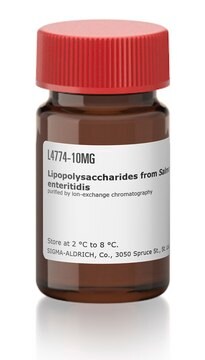437650
Lipopolysaccharide
from Salmonella typhimurium, , lyophilized, iNOS stimulator, Calbiochem
Synonyme(s) :
Salmonella LPS, Salmonella endotoxin
About This Item
Produits recommandés
product name
Lipopolysaccharide, Salmonella typhimurium, Stimulates the activity of inducible nitric oxide synthase.
Niveau de qualité
Forme
lyophilized
Fabricant/nom de marque
Calbiochem®
Conditions de stockage
OK to freeze
Impuretés
≤2% nucleic acid
≤2% protein
Solubilité
water: 5 mg/mL
Conditions d'expédition
ambient
Température de stockage
2-8°C
Description générale
Actions biochimiques/physiologiques
Inducible nitric oxide synthase
Avertissement
Reconstitution
Autres remarques
Mayeux, P.R., et al. 1995. Biochem. Pharmacol. 49, 115.
Norimatsu, M., et al. 1995. Infect. Immun.63, 1122.
Feinstein, D.L., et al. 1993. J. Neurochem. 60, 1945.
Zhang, Y.H., et al. 1993. Infect. Immun.61, 5044.
Informations légales
Mention d'avertissement
Danger
Mentions de danger
Conseils de prudence
Classification des risques
Acute Tox. 2 Oral
Code de la classe de stockage
6.1A - Combustible acute toxic Cat. 1 and 2 / very toxic hazardous materials
Classe de danger pour l'eau (WGK)
WGK 3
Point d'éclair (°F)
Not applicable
Point d'éclair (°C)
Not applicable
Certificats d'analyse (COA)
Recherchez un Certificats d'analyse (COA) en saisissant le numéro de lot du produit. Les numéros de lot figurent sur l'étiquette du produit après les mots "Lot" ou "Batch".
Déjà en possession de ce produit ?
Retrouvez la documentation relative aux produits que vous avez récemment achetés dans la Bibliothèque de documents.
Notre équipe de scientifiques dispose d'une expérience dans tous les secteurs de la recherche, notamment en sciences de la vie, science des matériaux, synthèse chimique, chromatographie, analyse et dans de nombreux autres domaines..
Contacter notre Service technique



